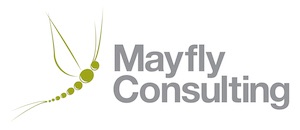Published: 21 Dec 2022
Leaders should learn the art of fly fishing
There is skill to fly fishing which only happens with practice. You must understand the balance between the rod and the line, then master the ability to gently flick your line over 30 yerds to a fish you may have spotted rising to sip a fly from the surface of the water.
Before that happens most people aimlessly thrash the water, ending the day with a sore shoulder and rarely catching any fish.

Once you become more proficient fly fishing starts before you’ve left your house! It’s about making sure you have the right selection of flies in your tackle box. Then, on arrival at your chosen location, simply noticing a few things can greatly improve your potential to catch a fish. Things like the temperature, how much light (or not) there is on that day and what kind of insects are stuck to your car windscreen are essential.
So, just doing some simple preparation and noticing what conditions there are on that day are a huge asset. After that its all about presentation, choice of fly and the ability to continually ‘read’ the conditions and adjust accordingly.
So, why am I writing about this on our website which is all about employees, leadership and engagement?
It’s exactly the same with employees!
Too many leaders and managers enter into conversations with their people without being well prepared and then wonder why they’re not getting enough traction with their employees.
Beyond that, it's vital to understand what subjects are important to their people individually. Using my fishing example, you must understand what they’re feeding on that day and match it from your fly box as best possible. 'One size fits all' simply doesn’t work.
Similarly with employees, what might be important to one may not be as high on their list of personal priorities as another.
And what can leaders do about this?
It starts by noticing things.
How does the office feel, is there a positive energy, or are people a little down?
What’s been going on in the local environment that day, week, or month?
If the team are under the cosh, do you really think a brand-new idea is what they want to talk about first? Perhaps, the starting point is simply asking them how they are, or listening to what they’ve been trying to do to enable their work to be successful or to overcome a particular challenge.
What might be important to the person you’re about to talk to (which fly will they prefer on that day)? If they’ve had a hard month then maybe cutting them a little slack or giving some time off might work for them.
If they’re full of energy, then maybe something to really stretch them.
In autumn, when trout are storing fat reserves for winter, they’re much more aggressive and will chase large gaudy flies because they want to eat. In contrast to a lazy summer day, you have to coax them with something more subtle.
Maybe I shouldn’t compare people with fish, but the principles remain – notice what’s going on, focus on the people’s needs not yours, and then present your thoughts (flies) in exactly the right way!
Finally, it doesn’t stop there … fly fishing involves catching fish of around 6 pounds with line that can break at if you load it with slightly higher weight. The subtle art of playing a fish occurs when you’ve hooked them.
With employees, maintaining focus, listening to needs, asking sensible questions and giving sound advice helps leaders remain connected, just like you need to be when fishing.
Leaders who don’t learn to fish well will go hungry and those who do will draw jealous glances from colleagues.
If you’ve never tried to improve your fishing technique perhaps now is the time to get in touch.
Tight lines everyone!
